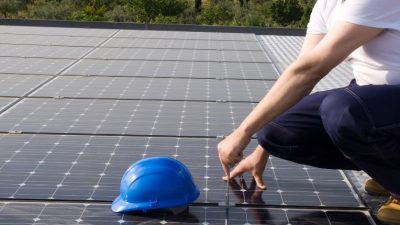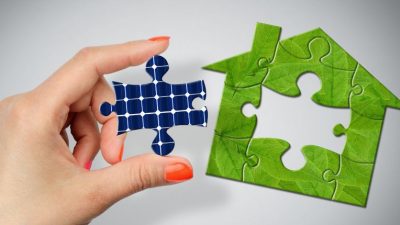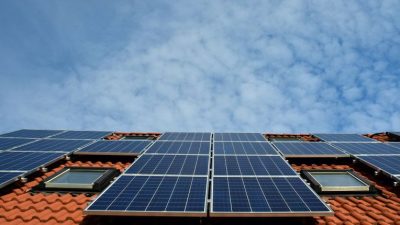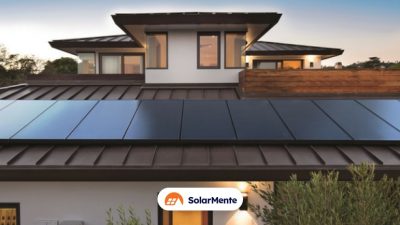Windows are everywhere: in homes, business buildings, cars, mobile phone screens, etc.
And this means that we have a lot of glass available.
But are we extracting its full potential?
As well as allowing sunlight in and views to the outside, they can generate energy.
We are not hallucinating or anything like that.
This is known as solar glazing or solar windows. Research in the solar energy market is making it possible to harness the elements of the building to produce electricity.
So if you want to know in detail what solar windows are, in this article we explain them to you. And we will also talk about:
- How solar crystals work
- Benefits and disadvantages of this technology
- Key factors before such an installation
- How much does a solar window cost?
- Future innovations
What is a solar window?
Solar windows, also known as solar glazing (so that there is no confusion throughout the article), are elements that form part of the building and, thanks to the composition of their transparent materials, absorb solar energy that is converted into electricity suitable for consumption.
Do you know what else they offer?
They provide light to the space just like any conventional window, with the advantage that inexhaustible and 100% clean energy can be consumed.
The technology is still under development, but with a promising future.
It all happened in 2017, when the journal Nature published a paper by scientist Richard Lunt and his team at Michigan State University. This report explains the development of a transparent material capable of generating electrical energy using infrared and ultraviolet waves.
But best of all, the solar crystals were able to produce up to 40% electricity.
And Lunt’s conclusion was that the combination of a system with solar panels, together with this new technology, could cover almost 100% of the energy demand of buildings and homes.
How solar windows work
Let’s see how this type of material works.
Solar windows are made of transparent glass in different grades or sizes that capture sunlight and convert it into electricity. The glass of which it is composed includes the following vital parts:
- Quantum dots. They capture sunlight and are located all over the surface of the glass.
- Solar cells. They cover the sides of the glass. Their function is to transform the light received by the quantum dots and convert it into electrical energy for consumption.
- Transparent Solar Luminescent Concentrator (TSCL). To be understood, it is an element that absorbs only the invisible light so that the visible light can pass through the glass and can be used from the inside without hindering visibility from the outside.
And what would you say is the difference compared to a photovoltaic installation?
Have you got it?
Let’s see if you’ve come close.
The advantage of solar windows is that they belong to the building construction itself. For this reason, they belong to BIPV, i.e. Building Integrated Photovoltaic Technology.
In this way what they do is:
- Capturing energy
- Transforming it into electricity
- Discreetly and efficiently
Benefits of installing windows with solar panels (or how to increase electricity savings)
Here are the advantages of this technology:
- More energy savings. Because if you already think it is remarkable how much your electricity bill decreases with a photovoltaic system, windows with solar panels add up to 40% more. But be careful, if we want to see results, we need to have a large glazed surface, an aspect that is difficult to achieve in today’s homes.
- It provides renewable, clean and cost-effective energy. We have savings, but we also reduce both personal and corporate carbon footprints.
- Increases thermal insulation. These elements are formed with double and even triple glazing and, in addition to the filters included, allow to maintain the correct temperature and not accumulate heat in summer. In the same way, it maintains the right temperature in winter. Better insulation and more energy efficiency.
- It does not require a complex installation and changing one window for another is no mystery.
- Diversity of models at your fingertips. You can personalise them as you wish. Sizes, frames and degree of transparency.
- They do not need extra space to produce energy.
- It does not affect the aesthetics of the house. As they are just another component of the building, the design is not altered and it is even difficult to see them from the outside. In reality, they are conventional windows in terms of design, but with the added bonus of capturing sunlight.
- The value of the property increases. In the same way that solar panels increase the value of a property, solar glazing also has this advantage. Think of your home as more self-sufficient.
And its disadvantages?
However, (let’s move on to the “buts”) we cannot ignore its disadvantages. As with any technology, there are always pros and cons, especially when it comes to research that is still under development.
The most significant is efficiency. Solar panels achieve an average efficiency of 20% which, depending on the quality of the materials and technology used in their manufacture, can be as high as 23%.
However, recent studies demonstrate the efficient growth of windows with photovoltaic panels. According to a report by the École Polytechnique Fédérale de Lausanne (EPFL), it confirms an efficiency between 15% and 30%.
In reality, it leads us to the promotion of passive or self-sufficient houses that manage to increase energy efficiency thanks to the use of natural resources.
Where can we use solar crystals?
We’ll tell you one thing: the versatility alone means that the applications extend to many different areas.
New developments, new applications. The range is getting wider and wider.
To give you an idea, it can be applied to street furniture, car parks, canopies and even car windows.
The solar energy sector is showing great interest in one material: graphene.
What is the reason for this interest, and is there anything special about it?
We are not only talking about the range-enhancing qualities of electric cars, but also the ability to generate energy through photovoltaic crystals.
This field extends to smart devices such as mobile phones and tablets.
As well as reducing our carbon footprint, it would give us greater autonomy. No more carrying your charger with you or running out of battery power when you’re out and about.
But that is not all. We are even talking about solar roads. Imagine the impact that would have on climate change.
As you can see, the applications are numerous, but let’s not forget that it is still a developing technology.
Key factors before installing windows with solar panels
Although we are still in the process of research, there are key factors that need to be known before such an installation is undertaken:
Window orientation
Just as the orientation of solar panels is important for capturing more solar energy, windows follow the same path. They must be optimally oriented if we want to maximise energy production.
In Spain, the appropriate orientation is south.
Space available for installation
To obtain a cost-effective amount of energy, a large glazing area is required.
What is the problem with housing in Spain? Most of them do not need enough space, since we are talking about 65% of the Spanish population living in flats.
However, single-family houses, as a rule, require more space. But beware, it is too early to see objective results. For the time being, as experts in solar energy, we repeat once again that this is a developing process and, at present, the best alternative is to install solar panels, whose efficiency is assured.
Degree of transparency
For solar windows to work, the glass must give up some of its transparency and most of it must be at a level of 70%. This depends on the thickness of the glass and the degree of transparency.
Therefore, this is one of the handicaps that solar windows currently have: opacity.
A 2022 report by a group of researchers at Tohoku University (Japan) shows the development of a nearly invisible solar cell. The publication shows how up to 79% transparency is achieved.
How much does a window with transparent solar panels cost?
We can give you an approximate figure, but you should bear in mind that these amounts vary.
What is the reason for this? There are many factors that affect the price. Consider the following:
- Technology
- Type of glazing
- Degree of transparency
- The efficiency of glass
That said, the price usually ranges between 18% and 20% more compared to a photovoltaic installation. But the good thing is that the return on investment accelerates faster thanks to its full potential.
And watch out, because just like solar panels, the following is true: they hardly need any maintenance.
Would you make an investment where you have to clean day in and day out?
Most probably not. Therefore, another great advantage is that it is low maintenance.
The future of solar windows: discover research that will revolutionise the energy market
What does the future hold?
Right now there is a lot of research online leading to increased energy efficiency.
Let’s get on with it!
Liquid coating
The American market has taken up the cudgels and a company called New Energy Technologies, has created a new material known as liquid coating which is intended for transparent surfaces. That’s right, like windows.
But do you know what it can do?
It absorbs light through conductors in the window frame. The energy is then produced and extracted for storage in batteries or devices that consume or supply it.
And here comes the icing on the cake.
In addition to producing energy when the sun is present, it has the ability to continue production even when the shadow is cast over us. All thanks to artificial light.
Yes, yes, you are reading correctly. It is not your imagination.
So its potential in housing and any type of building is abysmal.
Smart solar windows
We explain how this technology, led by a team led by Lance Wheeler of the NREL (National Renewable Energy Laboratory) in the USA, works.
They consist of nanocrystals that change depending on the light passing through them. In this way, both light and temperature can be efficiently regulated according to their location.
To understand it better, it is a system that works in a similar way to the blinds and curtains in your home. Now, is it?
Great, let’s move on.
And thanks to this light and temperature regulation, it has three different modes of use:
- Summer
- Siesta
- Winter
As well as other electrical appliances such as air conditioners.
But its full potential is extracted in geographical areas with adverse climates, where summers and winters are extreme.
The beauty of this technological breakthrough is that it can change the level of transparency depending on the light received and produce electricity when it is in opaque mode.
Organic solar cells
A competitor to silicon is emerging: organic solar cells.
It is an alternative to the main component of today’s solar panels. This initiative, led by researcher Olle Inganäs of Linköping University (Sweden), shows that there are other materials that can be used to generate electricity.
It is true that in terms of efficiency, it is not yet able to compete with silicon, but it is making its place in the sector.
Why does this method have a promising future?
The truth is that it has a number of advantages that make it an attractive technology to continue to invest in.
The cost of the materials is low, it allows a wide range of colours and its manufacture is a simple and fast process.
Solar windows: the components that will increase the self-sufficiency of homes
Remember Richar Lunt?
Yes, that researcher we talked about from the US University at the beginning of the article.
He says that – hang on to the fact – there are 7 billion square metres of glass surfaces in the United States alone.
In other words, the use of windows with solar panels could cover 40% of the electricity demand of this territory. It could even cover all this demand if storage methods are improved.
But it still shows limitations and its full potential has not been extracted. Do not take it as a replacement. Rather, it becomes an ideal complement to photovoltaic systems to make the most efficient use of electrical energy.
And although it is not yet suitable for housing, you know what you can do?
Go solar by installing solar panels on your roof. Because switching to self-consumption allows you to:
- Save on your electricity bill month after month – up to 50% or more!
- Caring for the environment by talking about a clean source.
- More independence from the electricity grid. Prevent the volatility of electricity prices from keeping you worried day after day.
Frequently asked questions about photovoltaic windows
Are solar windows enough to generate enough electricity for a whole house?
At present, they are not efficient enough to power a house. Large glazed surfaces are needed to generate the necessary electricity and become a cost-effective technology on their own.














